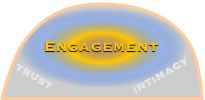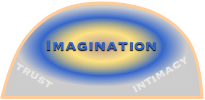Trust and the Triune Ethics Theory reviews Darcia Narvaez’s breakthrough Triune Ethics Theory paper and draws new insights into how trust and relationship building work, based on the human brain’s evolutionary development, structure, and functions. And it sheds light on how experiential social media increases intimacy.
Triune Ethics Theory, Darcia Narvaez, Ph.D.
 Triune Ethics is an enthralling, exceedingly useful approach to understanding human behavior because it explains the context of trust and relationship building at a profound level that is actionable for anyone who wants deeper, richer, more flexible connections and collaboration with people. Triune Ethics Theory will help me to educate my clients and teams at a deep level, and it can give you a rare understanding of your own behavior—and that of people around you.
Triune Ethics is an enthralling, exceedingly useful approach to understanding human behavior because it explains the context of trust and relationship building at a profound level that is actionable for anyone who wants deeper, richer, more flexible connections and collaboration with people. Triune Ethics Theory will help me to educate my clients and teams at a deep level, and it can give you a rare understanding of your own behavior—and that of people around you.
As with all my reviews, I will attempt to summarize this paper’s salient points before adding some reflections and conclusions about how I’m using its assertions in my work. As I have no formal training in neuroscience, I am drawing on lay study as well as psychology and my work in ethnographic research of social media. I highly recommend reading the paper, Triune Ethics: The Neurobiological Roots of Our Multiple Moralities, and delving into its sources. I have also included references for further reading at the end.
Overview
You have probably heard about the reptilian brain before, and perhaps the limbic system. I think that these primitive parts of the brain give a neurological context to what most psychologists call the unconscious, which I believe to be the engine of trust and relationship building among humans. People build trust and relationships with gut feel, i.e. unconsciously. If you want to test this, ask several friends and colleagues how they build trust and relationships; I think you’ll discover that few of them are very aware of how they do these things, what are their steps, goals, or methods. This is an indication that the verbally-oriented conscious mind, the Neocortex, is peripherally involved in trust and relationship building.
I think about this constantly because experiential social media is focused on communicating through action, not words, since words are of secondary importance in developing trust and relationship. I have developed experiential social media to build trust because trust is the prerequisite of risk-taking in business, collaboration, and innovation. Over time, I’ve come to think that experiential works because it communicates with these nonverbal reptilian and limbic brains. Triune Ethics Theory dives into the three main parts of the human brain and how they interact, what is important to each, and what kind of human behavior originates in each.
My reflections in this review will be especially diverse because Triune Ethics Theory contextualizes so many phenomena: trust building and breaking, relationships, current politics, community, business, and myriad others.
By the way, in case you find the summary of the paper dry or esoteric, I recommend skipping to the reflections to how it relates to trust building (the paper doesn’t explicitly discuss trust and relationship building) before reading the summary.
The Paper
First, Triune Ethics Theory (“TET”) provides an evolutionary aspect to brain development: reptilian, early mammalian (limbic), and late mammalian (neocortex). “Triune” refers to the fact that these parts in the brain are intertwined, i.e. interdependent, although each has its own “ethics,” which describe propensities and core sectors of behavior. TET is based on the pioneering work of Paul D. MacLean, an American neuroscientist. TET dives into each part of the brain, its characteristics and tendencies:
- The Reptilian (also “R-complex”) governs the Ethic of Security, which focuses on self-preservation through safety. It is akin to hard wiring, the most core of the core: if it fails to work, the animal dies.
- The Limbic is the home of the Ethic of Engagement, which is concerned with face-to-face emotional interaction, especially “caring relationships and social bonds,” caregivers, family, close community, etc.
- The Neocortex is responsible for the Ethic of Imagination, which is enabled by humans’ ability to reason in order to adapt oneself to innumerable social situations and trade-offs.
The Ethic of Security (Reptilian brain, R-complex)
 The R-complex relates to territoriality, imitation, deception, power struggles, and basic routines dedicated to survival—fear, anger, and core sexuality. The R-complex and its behaviors occur in reptiles and other animals. As our most core system, the R-complex is hard-wired into us, so we have it at birth, and it’s far less plastic than Limbic and Neocortex systems, which develop largely based on the childrearing environment. You can think of the R-complex as our default system, our MS-DOS or firmware, to take two computing metaphors. It has two emotional subsystems, Physical Survival and Thriving in Context. When the R-complex is threatened, it can overwhelm the more evolved parts of the brain. This is very important to keep in mind.
The R-complex relates to territoriality, imitation, deception, power struggles, and basic routines dedicated to survival—fear, anger, and core sexuality. The R-complex and its behaviors occur in reptiles and other animals. As our most core system, the R-complex is hard-wired into us, so we have it at birth, and it’s far less plastic than Limbic and Neocortex systems, which develop largely based on the childrearing environment. You can think of the R-complex as our default system, our MS-DOS or firmware, to take two computing metaphors. It has two emotional subsystems, Physical Survival and Thriving in Context. When the R-complex is threatened, it can overwhelm the more evolved parts of the brain. This is very important to keep in mind.
Physical Survival
Physical survival has three emotional systems: seeking, rage, and fear.
Seeking behavior is related metaphorically to “appetite.” It drives the animal to seek, obtain, and keep what it needs to survive such as food and shelter. The animal explores its environment to find and obtain what it needs, and it learns the most adaptive seeking behaviors through rewards and punishments/disappointments.
When physical safety is threatened, a rage system (“fight or flight”) or fear system (“freezing”) is triggered. The fear system functions to reduce pain and injury to the body. These systems tend to be inflexible; this part of the brain is hard-wired to do what’s worked for past generations. It’s largely instinctual.
In social animals like humans, the R-complex’s Security Ethic is extended from the individual to the ingroup, that is, a person’s closest relations (usually family). Territories, boundaries, and a natural fear of strangers are other concepts and characteristics. When the R-complex is threatened, it triggers tribalism, rivalry, and mob behavior. These are intense responses and can give rise to a phenomenon called the “superorganism” in which the group operates in very primitive ways, mobs, retribution, etc. Keep in mind that this is unconscious behavior; people are not aware of what is driving their behavior, but physical survival behavior is exceptionally powerful. When the R-complex overwhelms the Neocortex, unconscious behavior reigns, and this occurs at an ingroup level, too. The Neocortex is the origin of conscious awareness, so when it’s short-circuited by the R-complex, exceptional behavior can result.
Thriving in Context
Thriving in Context is the second concern of the Security Ethic. It is focused on primitive interactions with other animals, for example how the animal relates to others in the group at a primitive level. Status and dominance are two key concerns.
The Security Ethic develops moral behavior from instincts grounded in the R-complex. When these instincts are active, people rigidly follow traditions and are often intolerant of exceptions. They insist on loyalty to the ingroup and shame people who question tradition, rules, thoughts, or beliefs. They can be ruthless because they want to feel safe when they are feeling threatened. People are “attracted to strongmen and tough policies on outsiders” (tribalism). People are less interested in helping others, so altruism diminishes markedly. They reject “soft emotions” in favor of obedience, loyalty and self-control. [Keep in mind that this is our core system and few people want to admit it, so they repress these drives, and repression makes them even more powerful and unpredictable].
The Ethic of Engagement (Limbic system)
 The Limbic system developed after the R-complex (appeared later in evolution), so I think of the Limbic as being built on top of the R-complex. The Limbic gives the animal more evolved emotions. MacLean proposed it as the basis for human emotion, personal identity, experiential memory, and a person’s sense of reality and truth. [Narvaez doesn’t write this, but I observe that the Limbic is mostly nonverbal in orientation.] The Limbic is the basis for three types of behavior in mammals: nursing/maternal care, “audiovocal communication” between mother of offspring, and play.
The Limbic system developed after the R-complex (appeared later in evolution), so I think of the Limbic as being built on top of the R-complex. The Limbic gives the animal more evolved emotions. MacLean proposed it as the basis for human emotion, personal identity, experiential memory, and a person’s sense of reality and truth. [Narvaez doesn’t write this, but I observe that the Limbic is mostly nonverbal in orientation.] The Limbic is the basis for three types of behavior in mammals: nursing/maternal care, “audiovocal communication” between mother of offspring, and play.
The Ethic of Engagement has emotional systems that lead animals (humans, primates, and other mammals) toward intimacy: play, panic, and care. Play promotes harmony, sociality, and learning. Panic is vital to humans because we are born one year premature and require prolonged protection and nurturing, so premature separation equates to death. Mammals by definition are breastfed and nurtured for an extended period of time. Isolation [separation] creates distress in infants since they lose their food source and protection when they lose their mothers. Similarly, care emotions are triggered in parents [mothers], so they will nurture their young long enough for them to thrive. Narvaez states that the pressure to conform and to submit to authority may be related to the fear of separation.
How the Engagement Ethic Is Co-Constructed
Unlike the Security Ethic, which is hard-wired, the Engagement Ethic is “co-constructed by offspring and caregivers and formed by experience during an extended childhood.” This means that, although it has propensities, its development and functioning are subject to wide variation based on childrearing experiences. Fascinatingly, humans share Engagement Ethic behaviors with chimpanzees and bonobos, so I find this a wonderful sense of connection!
For example, the degree to which a child is held, nursed, touched and kept near caregivers translates into how intimate, trusting, and confident that child becomes, and how productive in social settings and group activities. Moreover, the Engagement Ethic’s development is largely a once-in-a-lifetime opportunity. The brain mushrooms in development during early childhood, and subsequent development is dependent on development that’s come before, as a skyscraper depends on the piles of its foundation that extend deep into the ground. So you can’t “go back” and “redevelop” later.
The Engagement Ethic’s trust and attachment (to other people) is fragile and pivotal in a person’s ability to regulate his/her emotions as well as social and moral behavior.
The Engagement Ethic’s trust and attachment (to other people) is fragile and pivotal in a person’s ability to regulate his/her emotions as well as social and moral behavior. The Engagement Ethic is socially developed. Again, Narvaez doesn’t write this, but I think it’s implied that the Limbic brain is pre-linguistic: intimacy and affiliation in primates are built through physical touch, commitment and other nonverbal gestures during infancy. Moreover, mammalian brains develop “capacities of limbic resonance… mutual exchange and internal adaptation whereby two animals become attuned to each other’s inner states” (think mother/child interaction determining how empathic a child will become). Further, the mammalian nervous system’s stability results from the child’s formative experience with caregivers and close attachment figures. It’s how people form the ability to deal with their most powerful emotions. “The mammalian nervous system is incapable of ‘self-assembly’, requiring limbic regulation to centrally harmonize and coordinate the various parts.” Persistent early childhood stress permanently affects the production of hormones, i.e. how capable the adult will be to deal with stress.
In addition, “With adequate care, the Engagement Ethic develops fully and leads to values of compassion, openness and tolerance… Care-deprived infants develop aberrant brain structures and brain-behavioral disorders which lead to greater hostility and aggression towards others.”
The Ethic of Imagination
 The Neocortex and related structures evolved on top of Limbic and R-complex parts of the brain. It … “is focused primarily on the external world, providing the capacity for problem solving and deliberative learning.” This is so much more than rational thought: “The mind ‘thinks with feelings’ and ‘is neither an airy spirit nor an exquisite computing device but a creaky old calculator sunk in a sticky swamp of feelings’… Thinking without feeling, as some brain damaged patients do, leads to a disruption in judgment because to make a good judgment one must feel the meaning of the judgment… In truth, we think because we feel what we are.”
The Neocortex and related structures evolved on top of Limbic and R-complex parts of the brain. It … “is focused primarily on the external world, providing the capacity for problem solving and deliberative learning.” This is so much more than rational thought: “The mind ‘thinks with feelings’ and ‘is neither an airy spirit nor an exquisite computing device but a creaky old calculator sunk in a sticky swamp of feelings’… Thinking without feeling, as some brain damaged patients do, leads to a disruption in judgment because to make a good judgment one must feel the meaning of the judgment… In truth, we think because we feel what we are.”
The Neocortex is critical in dealing with ambiguous situations, flexible thinking, abstraction, and free choice. Furthermore, “… a distinction has been made between the deliberative, conscious mind and the adaptive unconscious or intuitive mind. Triune Ethics Theory suggests that the real work of moral judgment and decision making has to do with the coordination of these two ‘minds.’”
The Most Human
The Imagination Ethic in humans is our most distinctive trait, although chimpanzees and bonobos also have degrees of it, too, just less than humans. In general, it is the source of what we consider to be conscious thinking, reflection, and abstraction. Moreover, “The Imagination Ethic responds to and coordinates the intuitions and instincts of the Engagement Ethic and the Security Ethic, which operate according to conditioned and implicitly extracted moral principles.”
The Imagination Ethic sorts out the multiple elements that are involved in moral decision making in a particular situation…
“The Imagination Ethic sorts out the multiple elements that are involved in moral decision making in a particular situation, elements such as contextual cues, social influence, current goals and preferences, mood and energy, environmental affordances, logical coherence of action possibilities with self image and with prior history. Wrestling with these elements includes a simultaneous assessment of multiple factors: gut feelings; principles (e.g., being a kind person, being a team player); balancing one’s goals/needs with the goals/needs of others in the circumstances; keeping track of reactions and outcomes (of self and others); and consciously letting go of conflicting (sometimes moral) goals.”
The Imagination Ethic has two distinctive tools. First, it has the ability to countermand instincts (“free won’t”) by recognizing a primitive emotion and deciding whether to heed it. Second, it can frame behavior, understand and explain past behavior according to a narrative.
“Although the deliberative mind may learn particular principles from upbringing or schooling, such deliberative learning may not trump the deeper tacit understandings, learned from life experience. Thus the Imagination Ethic operates in interplay with the other ethics… Even with nurturing care early in life, the prefrontal cortex is susceptible to damage in adolescence and early adulthood… It may [also] be damaged by behavior choices such as binge drinking, and violent video game playing, which suppress activation of the prefrontal cortex even during normal problem solving, turning normal brains into ones that look like those of aggressive delinquents.” The Imagination Ethic is more obviously moral than the other ethics. It provides a means for imagining community beyond the immediate context [i.e. imagining future generations].
Reflections: Trust and the Triune Ethics Theory
 In summary, I think of the interconnected parts of the brain—the R-complex, Limbic system, and Neocortex—as the wiring, and the ethics as their output, which is largely the result of upbringing experiences (the R-complex excepted).
In summary, I think of the interconnected parts of the brain—the R-complex, Limbic system, and Neocortex—as the wiring, and the ethics as their output, which is largely the result of upbringing experiences (the R-complex excepted).
- For example, a child who is emotionally neglected in early childhood may have limbic wiring, but the caregiver interaction is missing, so the child cannot fully develop its Engagement Ethic, the ability to empathize or relate to her/himself or other people.
- Another child that suffers prolonged stress and fear may develop a heightened Security Ethic and may be subsequently dominated by safety concerns as an adult.
- Children whose upbringings are within “normal” bands can more fully develop their Imagination Ethic, which enables them to consider and live in situations beyond immediate self-interest and to think impartially about a wide range of factors.
- The Neocortex, as wonderful as it is, is a Johnny-come-lately; its abstractions and coordination are also conditional on the immediate environment. If the Security Ethic is active, it can over-ride the operation of the Neocortex. Trust is largely the purview of the nonverbal Limbic system. But conscious awareness is the purview of the Imagination Ethic.
- Various situations tend to trigger different ethics.
Security Ethic
I find Triune Ethics Theory, even at a basic level, to be extremely useful and practical for anyone who wants to interact with her/himself and other people more flexibly and deeply. For example, it is extremely useful to understand the Security Ethic and its tendencies and indications. Imagine that you find yourself in a situation at work when a large layoff has been announced. You can immediately be more aware of yourself and other people by recognizing that the Security Ethic will be active. And the Security Ethic trumps the others, but you can appreciate this, in yourself and in others, so you can be more empathic and responsive, to your own feelings and to others’ emotions.
Keep in mind that most people don’t like the primitive emotions generated by the Security Ethic, so they often repress and deny them. Knowing this can help you improve your understanding of and communication with yourself and other people.
Engagement Ethic
I think of the Engagement Ethic as the seat of a person’s emotional and relating toolbox. Narvaez points out that the Engagement Ethic is focused internally and externally. That is, it governs one’s relationship to oneself as well as to other people, groups and collaboration. Moreover, it is nonverbal. Remember, it is co-created, largely during infancy, pre-verbally. Therefore, its “language” is gestures, touches, interactions. If you want to relate to people at a deep level, don’t use words, use gestures. For example, if you want to communicate that you care about someone who is upset, you will not “get through” to him/her by saying that you care. A more effective way is to stand/sit beside him/her, just being present, without doing anything else.
Simply sitting or standing by a person, without imposing or saying anything is an extremely powerful way to show your care and support. This is a key way to show support in the primate world. Try it.
Trust and Intimacy
“Actions speak louder than words” is an easy way to think about communicating in ways that lead to trust and intimacy. When a mother breastfeeds her child, all the touching is actually wiring the baby’s Engagement Ethic by activating and building neural pathways. I think of the latter as circuits, and the more current that flows through them, the “thicker” they become. If a mother consistently feeds her baby several minutes after it is hungry, that baby will understand that it is not very important, and this attitude will manifest internally (“I’m not important, valuable..”) and externally (“I have nothing to say, little to contribute”). Conversely, a mother who consistently anticipates (through limbic resonance) and responds to her baby’s needs will wire her baby to feel important, “loved,” and confident in groups.
Remember, the more primitive parts of the brain are more powerful than the more evolved parts. For example, the Security Ethic can take over a person’s behavior when it is very active, and the person will not be aware of it because the Neocortex is the center of most self-awareness. Similarly, the Engagement Ethic’s emotions, gut feel, usually makes decisions that involve risk, but the person usually rationalizes the decision through the Imagination Ethic.
I posit that trust and relationship are largely built by engaging the Security and Engagement Ethics. For example:
- When a person’s/group’s Security Ethic is active, and you recognize it and interact with empathy, you will make a powerful impression, although the person/group will probably not recognize it verbally. When the Security Ethic is active, it’s not a good time for abstractions and complex explanations. Think about how you can help people feel safe. Sometimes you can’t, but you can be understanding and avoid imposing on them, so they have the space to get to safety, in their own terms.
- When the Engagement Ethic is active, emotions are highlighted. A person may feel any number of things, and having another person (you) considering their actions and responding to them without saying anything will feel very good (you can practice limbic resonance, which feels comforting). For example, you can note how fast a person’s gestures are, and her/his posture as a guide to how s/he may want support.
- Avoid the tendency to verbalize. Although the Engagement Ethic is closer to conscious awareness than is the Security Ethic, many people repress or deny their emotions, especially in formal settings. You can respond without verbalizing, and note body language to verify the other person’s response to you.
- People are very responsive to others who consistently have limbic resonance with them and others close to them. I practice this with my relationships as much as I can. I think that limbic resonance is mostly nonverbal, precisely because it’s unconscious; people have learned to trust nonverbal more than verbal because nonverbal is less conscious. Notably, lying is done using the Neocortex because it is usually conscious, a deliberate abstract fabrication. Body language is far less conscious and more telling. Of course, deception can be nonverbal, but it is usually simple. Chimpanzees are master deceivers.
- The key to successful relationships is one’s relationship with oneself because congruence is a cornerstone of trust building, doing what one says one will do—consistently. For example, pretending to be chummy with a colleague from whom you want something is a kind of lie. But most people’s body language (Engagement Ethic) will betray them, and the colleague will detect, usually unconsciously, the deception. So I avoid the need to deceive by accepting and honoring my true feelings. That can be difficult in some situations, but I find it preferable. Even if I openly disagree with someone, I will usually earn trust with her/him as long as I do so respectfully: people prize consistency more than anything. It’s practical for people to feel like they can predict your behavior (consistency), to feel like they “know where they stand” with you, even if they disagree with you. They can count on you to be you.
Imagination Ethic
Conscious and Unconscious
One of the most important realizations is that the Neocortex can think about, and countermand, emotions that originate in Limbic and Reptilian brains—but it does not control them.
It is difficult to countermand thoughts and feelings originating in Reptilian and Limbic parts of the brain because doing so “goes against one’s instincts.” In fact, the Reptilian is the most powerful of the three. Similarly, you can’t build trust or intimacy by talking about how you care about someone (relate to his/her Limbic brain). Words are artifacts of the Neocortex.
I think that the Limbic and Reptilian brains loosely map to the Unconscious as described by Jung, and the Neocortex to the Ego (The Jungian Model of the Psyche). From my personal experience with dream interpretation, I imagine that dreams require interpretation because they largely stem from the unconscious and are pre-verbal. That means that their language is symbols, not words, and dream interpretation involves interpreting the symbols. Provisionally, I extend this thinking to experiential social media and its trust- and relationship-building abilities.
I experience the three ethics as a wonder. I consider them to be separate. That means they have separate proclivities and concerns, and two of them are nonverbal. I have consciously used dream interpretation to build trust between conscious and unconscious parts of my self. Ego/Neocortex runs the interpretation, but, by expending the effort to reflect on and interpret Unconscious’s symbols, Ego sends a message—that he cares.
One of the most powerful ways you can communicate that you care is to be present, to spend time, with someone without imposing on him/her. I spend time with my unconscious during dream interpretation. Over time, the breadth and depth of my dreams has increased significantly. I use this experience to guide my practice of experiential social media. To communicate to someone online that I care about her/him, I consider what s/he is talking about. I ask open-ended questions because they are invitations for her/him to share more. Open-ended questions create a space into which you invite the other person. The gesture of asking is what’s most important. It’s especially poignant when the person is angry. And observers get this and are affected by it.
Think about your experience with other people or with your self: how often do other people show sincere interest in your thoughts and feelings, ask open-ended questions, then reflect and suggest things? How often do you ask yourself open-ended questions? For many people, this is rare.
Politics and History
Although this topic definitely demands another post, I want to make the connection between the Security Ethic and the current political climate. Since the 1980s, I have been on the front lines of the breakdown of the Industrial Economy and its social contract. For the first time ever, I think, the majority of Americans believe their children will be worse off than they.
“The economy” engages the Security Ethic on many channels. Uncertainty about income. Many researchers theorize that economic uncertainty is a driver of the opioid crisis. Robots. Terrorists. Note that, when active, the Security Ethic leads to “strongmen” (i.e. fascists) who are intolerant of outsiders. Reread the Security Ethic in the context of current politics, and I think you’ll get the connection.
As for me, I perceive current politics, although I’m aghast at much of it, with much more patience and understanding. Having majored in history during undergrad, I understand these historical events in the context of people trying to feel safe. And I understand it in terms of the inherent uncertainty of adapting to the Knowledge Economy, so it’s not the result of a person or a country; it’s a need that all people have. And no one can “solve” it, either. It’s an historical event that’s unfolding in our present.
The Security Ethic, which originates in the Reptilian brain, explains much of Trump’s appeal, and other relatively extreme politics worldwide. The Industrial Economy is breaking down across the world, thereby stimulating the R-complex. This insight underlies the Social Channel.
Further Reading
I learn when I write book reviews, and here are some of my reviews about the brain, and decision making. All of these follow a similar format to this review; I summarize the work before applying it to human behavior and experiential social media.
- Robin Dunbar’s Grooming, Gossip, and the Evolution of Language explains humans’ evolution in a most fascinating way, including the assertion that humans are born one year premature.
- Chimpanzee Politics is Frans de Waal’s groundbreaking book that summarizes some of his research of a chimpanzee community. He explicitly refers to Machiavelli’s The Prince and reveals that much of what we consider “human” is not ours; for example, chimpanzees share long-term strategic political thinking.
- Bonobo Handshake is a fascinating book that describes what happens when chimpanzee-oriented primatologists research bonobos, which reset the paradigm—because they are so different in important ways (one difference is that they are matriarchal).
- Everything Is Obvious* explores the brain more in the sense of the biases of “common sense” and why and how it operates and trips us up.
- Numbers Rule Your World offers another view into human bias—because our brains cannot fathom big data and complex systems. Kaiser Fung is a statistician who writes engagingly and includes numerous case studies of faulty human thinking; our brains are wired to take shortcuts (common sense is an example), but this creates disasters when we do it while interacting with complex systems.
- I riff more extemporaneously on the brain and dream interpretation in Practiced Ignorance.

Leave a Reply
You must be logged in to post a comment.